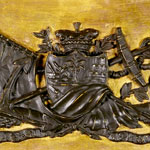Admiral Lord Nelson - A George III Gilt Wood Pier Glass, 1800
Adding product to your cart
115cm (45.25in) x 72.5cm (28.5in)
Gilt wood pier glass, the frame comprising fluted pilasters supporting a frieze decorated with Nelson heraldry and iconography relating to the period 6 November 1798 to 22 May 1801, the whole capped by a cornice of ribbon and ball design.
The frieze design on the present mirror indicates it was created following Nelson’s enoblement in November 1798 as Baron Nelson of the Nile, and of Burnham Thorpe following his destruction of the French fleet at the Aboukir Bay. The baron’s coronet displaying four ‘pearls’ was of course upgraded in 1801 on Nelson’s advancement to a viscountcy.
Read more
The heraldic trophy of arms alludes to the Battle of the Nile through the inclusion of smoking cannon and laurel branches of the victor. Naval emblems include an anchor and an ensign. The latter serves the double function of obscuring the ancient family arms (of Nelson of Lancashire - Or, a cross flory Sable, over all a bendlet Gules) - and highlighting the augmentation granted by George III to Nelson in respect of the Battle of the Nile - ‘a chief undulated Argent, and thereon waves of the sea with a palm-tree between a disabled ship on the dexter side and a battery in ruins on the sinister, all proper’. The only part of the lower section of the shield that is visible, gives a glimpse of an earlier augmentation (granted for Nelson’s role in the Battle of Cape St. Vincent in 1797 - 'a bend Gules surmounted by another bend engrailed Or and thereon three bombs fired proper'). The palm branches reference Nelson's personal motto ‘PALMAN QUI MERUIT FERAT’ (Let him bear the palm of victory who has won it), and also reflect a further Nile augmentation to his armorial bearings (- viz: supporters - ‘in the hand of the Sailor a palm branch, and another in the paw of the Lion, both proper, with the addition of a tri-coloured Flag and Staff in the mouth of the latter’).
Nelson’s enoblement as a baron was the cause of some controversy, not least because Admiral Jervis after St. Vincent, and Admiral Duncan after Camperdown had both been made viscounts. Emma Hamilton gave vent to her outrage. "Hang them, I say! If I was King of England, I would make you the most noble puissant Duke Nelson, Marquis Nile, Earl Alexander, Viscount Pyramid, Baron Crocadile (sic)." In the House of Commons it was suggested that Nelson should be offered a higher degree of rank; but Pitt thought it “needless to enter into the question of rank". Admiral Nelson had obtained a great victory, "and no man would think it worth while to ask whether he had been created a baron, a viscount or an earl." In the end Lord St Vincent smoothed the waters by reminding Nelson that "It is the highest honour that has ever been conferred on an officer of your standing in the Service, and who was not a Commander-in-Chief."
The present gilt wood mirror can be ascribed to a small group of similar documented mirrors showing Nelson’s coat of arms which may have come from Merton Place, the house in Surrey which the admiral shared with his mistress Emma, Lady Hamilton. The mirrors vary in the arrangement of the armorial and trophy design with other examples showing a battle honour scroll for Trafalgar. Naturally mirrors lacking the Trafalgar scroll have the only claim to have been made during the admiral’s lifetime. Others may have been displayed by close members of Nelson’s family such as his brother William, 1st Earl Nelson (1757-1835).
Visitors to Merton Place commented, not always favourably, on the richly decorated interiors where Nelson’s many trophies and portraits jostled for attention. ‛Not only the rooms,’ sniffed Lord Minto, ‛but the whole house, staircase and all, are covered with nothing but pictures of him and her, of all sizes and sorts, and representations of his naval actions, coats of arms, pieces of plate in his honour, the flagstaff of L’Orient &c., an excess of vanity which counteracts its own purpose.’ Others noted the widespread use of glass to fill the house with light and reflect its illustrious inhabitants.
Following Trafalgar, facing ruinous debts, Emma was obliged to dispose of Merton and disperse its contents in a series of auctions and private sales making it difficult today to trace the original furnishings. However, period art works decorated with Nelson’s pre-Trafalgar honours such as this mirror make a compelling case as having been purchased for Merton.
A related gilt wood pier glass with identical coat of arms, but lacking the trophy of arms, is currently on display at the National Maritime Museum, Greenwich where it features in the exhibition ‘Emma Hamilton: Seduction & Celebrity’ to illustrate life at Merton.








